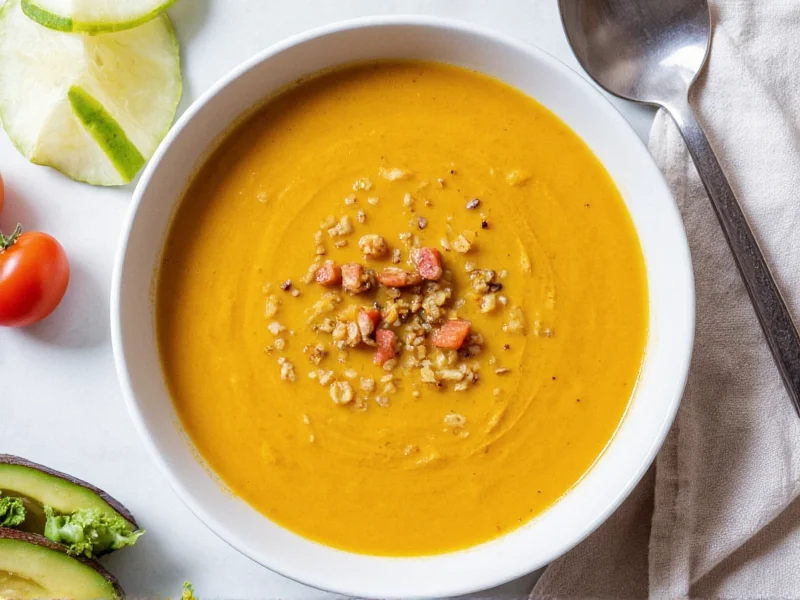The Science Behind Exceptional Soup Making
Creating memorable soups isn't accidental—it's the result of understanding culinary chemistry. When vegetables like onions, carrots, and celery (the classic mirepoix) hit hot oil, the Maillard reaction creates hundreds of flavor compounds. This foundational step separates adequate soups from extraordinary ones. Professional chefs dedicate 15-20 minutes just to properly sweating aromatics, allowing flavors to develop without browning.
Stock quality determines 70% of your soup's final taste. While store-bought broths work in a pinch, homemade bone broth simmered for 12-24 hours extracts collagen that gives body and mouthfeel. For vegetarian options, roasted mushroom trimmings and kombu add natural umami. Always season in layers—add salt at each stage rather than all at once—to build complexity.
Essential Techniques for Perfect Soups Every Time
Master these professional methods to elevate your soup game:
| Technique | Key Benefit | Pro Tip |
|---|---|---|
| Sweating vs. Sautéing | Develops sweetness without bitterness | Cover pan for first 5 minutes to steam vegetables |
| Acid finishing | Brightens flavors and balances richness | Add lemon juice or vinegar after cooking |
| Emulsification | Creates creamy texture without dairy | Blend 1/3 of soup with reserved beans or potatoes |
| Reduction | Intensifies flavors naturally | Simmer uncovered for final 20 minutes |
7 Restaurant-Quality Soup Recipes Worth Mastering
1. French Onion Soup with Perfect Caramelization
This authentic French onion soup recipe requires patience but delivers unmatched depth. Use yellow onions only—their sugar content creates ideal caramelization. Cook over medium-low heat for 45 minutes until deep mahogany brown. Deglaze with dry sherry before adding beef stock. Top with baguette slices and Gruyère for the classic finish.
2. Creamy Tomato Basil Without Cream
For a healthy tomato basil soup recipe that's velvety without dairy, roast Roma tomatoes with garlic until blistered. Blend with soaked white beans for creaminess and fresh basil added at the end. A splash of balsamic vinegar balances acidity better than sugar.
3. Chicken Noodle Soup with Homemade Broth
The secret to the best chicken noodle soup recipe lies in the broth. Simmer chicken bones with apple cider vinegar for 4 hours to extract maximum collagen. Add noodles during the last 8 minutes of cooking to prevent mushiness. Finish with fresh dill and a squeeze of lemon.
4. Miso Soup with Perfect Umami Balance
Authentic miso soup recipe for beginners starts with dashi made from kombu and bonito flakes. Never boil miso—whisk into broth off-heat to preserve probiotics. Add wakame seaweed and silken tofu just before serving. Garnish with scallions cut on a diagonal.
5. Butternut Squash Soup with Depth
Elevate your easy butternut squash soup recipe by roasting squash with smoked paprika. Sauté apples with the aromatics for natural sweetness. For richness without cream, blend in roasted cashews. A drizzle of pumpkin seed oil adds nutty complexity.
6. Minestrone with Authentic Italian Flavors
This hearty minestrone soup recipe follows Italian tradition: start with soffritto (onion, carrot, celery), add pancetta for depth, and finish with pesto. Use borlotti beans and seasonal vegetables. The secret? A Parmesan rind simmered in the broth.
7. Seafood Chowder Without Heavy Cream
Create a restaurant-style seafood chowder recipe by making a roux with bacon fat. Use clam juice and fish stock as the base. Add seafood in stages—firm fish first, delicate shellfish last. Finish with a touch of sherry and fresh thyme.
Avoid These Common Soup-Making Mistakes
Even experienced cooks make these errors that compromise soup quality:
- Overcrowding the pot—adding too many vegetables at once lowers the temperature and steams rather than sautés
- Adding salt only at the end—season in layers to build flavor complexity
- Boiling instead of simmering—vigorous boiling breaks down delicate ingredients and creates bitterness
- Using dried herbs exclusively—add delicate fresh herbs like basil and cilantro at the very end
- Rushing the process—soups need time for flavors to meld (minimum 20 minutes simmering)
Customizing Soups for Dietary Needs
Adapt any vegetarian soup recipes by substituting mushroom dashi for meat stocks. For gluten-free versions, use cornstarch or arrowroot instead of flour for thickening. To reduce sodium without sacrificing flavor, increase umami ingredients like tomatoes, mushrooms, and nutritional yeast.
When making healthy soup recipes for weight loss, focus on volume eating—load up on non-starchy vegetables while keeping broth light. Add protein through beans, lentils, or lean chicken. Avoid cream-based soups if watching calories, but don't skip healthy fats entirely—a drizzle of good olive oil at the end enhances flavor absorption.
Proper Storage and Reheating Techniques
Soups actually improve overnight as flavors meld. Cool properly by placing the pot in an ice bath, stirring occasionally. Store in airtight containers with 1-inch headspace for expansion. Most soups keep 4-5 days refrigerated or 3 months frozen.
When reheating leftover soup recipes, do so gently over medium-low heat. Add a splash of water or stock if too thick. For cream-based soups, whisk constantly to prevent separation. Always taste and adjust seasoning after reheating—flavors change during storage.











 浙公网安备
33010002000092号
浙公网安备
33010002000092号 浙B2-20120091-4
浙B2-20120091-4